TURKEY POINT LIGHT STATION
NORTH EAST, Maryland
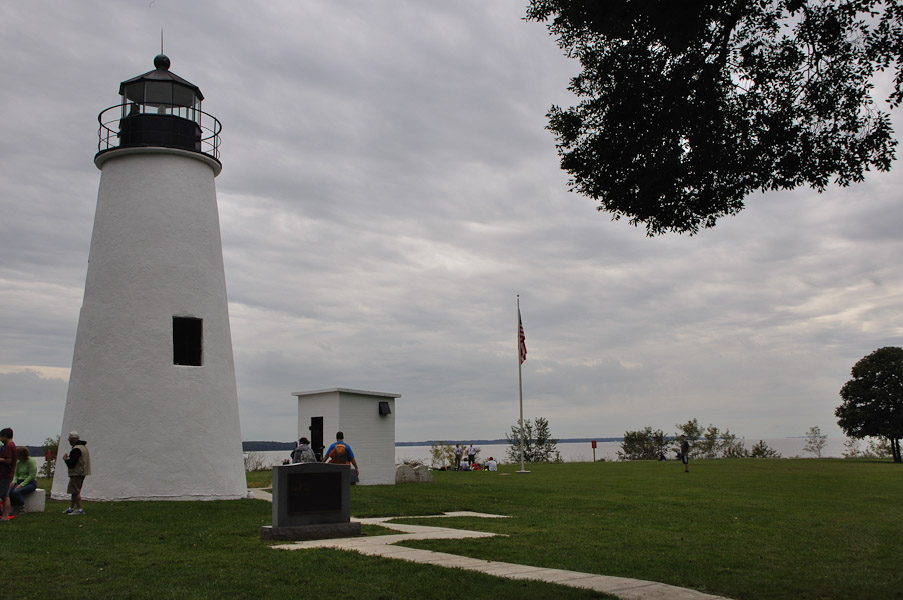
Turkey Point Lighthouse is located on four acres on the southern most end of
the Elk Neck State Park in beautiful Cecil County, Maryland.
Turkey Point is easily accessed by following MD-272 to the park
parking lot and hiking 8/10ths of a mile.
The historic lighthouse tower and oil house are situated on a
100-foot bluff at the confluence of five rivers as they meet the Chesapeake
Bay.
Plans for a lighthouse at Turkey Point began as early as 1812 by the U.S.
Lighthouse Service known today as the Coast Guard.
The land to build the light station was purchased by the federal
government in 1832. The Turkey
Point Light Station was to be a “family station” that required a keeper’s
house and additional buildings necessary to sustain a family and maintain
the light station. John
Donohoo, a civic minded lighthouse builder from Havre de Grace, Maryland
completed the light station in 1833.
He built 11 more lighthouses on the Chesapeake Bay in Maryland (of
which seven still survive) including Concord Light in Havre de Grace.
He built one lighthouse in Virginia.
The original configuration of the Light Station buildings included the
35-foot lighthouse tower, the keeper’s house, a fog bell tower and several
service buildings. All that
remains today is the lighthouse tower, the oil house and concrete fence
posts that surround what used to be the light station’s garden.
The keeper’s house and outbuildings were demolished in the early
1970’s.
The lighthouse’s beacon guided mariners down the Elk River to the mouth of
the newly completed Chesapeake & Delaware Canal.
The lantern room of the lighthouse also had a pane of red glass
(called a “Red Sector”) to warn sailors aaway from the Susquehanna Flats.
The lantern used a fourth-order Fresnel lens imported from France.
The lens consisted of a cylinder of brass and glass prisms.
Turkey Point has the highest lantern room of any Maryland lighthouse
located on the Chesapeake Bay.
The Fresnel prisms had to be cleaned daily and polished weekly in order for
the light to be seen 13 miles down the Bay.
Also, three brass oil lamps had to be filled and cleaned daily.
The last lamp used an Aladdin oil lamp because of its superior
brightness. The light only used
a single lamp but a second lamp was kept ready for emergency service and a
third was used to go between the lighthouse and the keeper’s house.
In early 1943, the lighthouse was electrified reducing the light keeper’s
frequent daily trips to maintain the light to one.
The need for the keeper’s house was eliminated when complete
automation was achieved. The
brass lamps were still maintained in case the electricity failed until
Fannie Mae Salter, the last lighthouse keeper, retired in 1948.
The light was initially a fixed light but after complete automation in 1948,
the light was changed to a flashing light.
Turkey Point was assigned a flash pattern of one second “On” and five
seconds “Off”. Today the beacon
is powered on and off by a light sensitive sensor.
Power is provided by a solar panel that stores electricity in two
deep-cell marine batteries residing up in the lantern room.
KEEPERS OF THE LIGHT
It took a special kind of person to “keep a light.”
The Fresnel prisms had to be cleaned every day, the fuel carried up
to the light, the wick trimmed and replaced if necessary and the lamp lit in
the evening and extinguished in the mornings.
This was a daily job irregardless of the weather.
When the fog bell tower mechanism malfunctioned, the keepers had to
physically ring the warning bell at the proper interval, sometimes for long
periods of time.
Turkey Point Light Station was an isolated, self-sufficient existence for
the keepers. While some
supplies came by boat from Havre de Grace, North East (the nearest
settlement) was over 12 miles away, a considerable distance in the
pre-automobile era. As a
result, the keepers and their families farmed the adjacent land, raised
livestock, hunted wildlife in the forest, and harvested the bounty of the
Bay.
List of the Keepers and their dates of service:
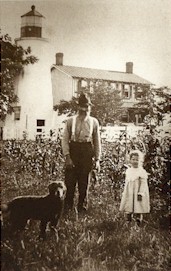
Purchase copies of this postcard here.
1833-1841: Robert Lusby
1841-1843:
John C. Waters
1843-1844:
Robert Lusby
1844-1862:
Elizabeth Lusby, wife of Robert Lusby
1862-1865:
Edward Clonan
1865-1873:
John Crouch
1873-1895:
Rebecca Crouch, wife of John Crouch
1895-1919:
Georgiana Brumfield, daughter of John and Rebecca Crouch
1920-1922:
Caleb Stowe
1922-1925:
Clarence Salter
1925-1948:
Fannie Mae Slater, wife of Clarence Salter
1948-2000:
Automated (had no keeper)
Spring 2000:
De-commissioned by U.S. Coast Guard and leased to TPLSI for
30 years
November 2002: Relit as a
Private Aid to Navigation
Spring 2006:
Deed was transferred to the State of Maryland and remains leased
to TPLSI as Turkey Point’s Chief Operations Agent.
Spring 2007:
The current Spiral Stairs were rebuilt using the original blueprints.
The outside of the lighthouse and the lantern room were also
completely refinished. These
improvements were funded by TPLSI.
Of the ten keepers at Turkey Point, four were women and three were wives
that
THE KEEPER’S HOUSE
Our current plans are to reconstruct the light keeper’s house as a fully
habitable building. While
faithful to the original blueprints, we intend to provide access ramps for
physically handicapped visitors.
The light keeper’s house will house displays and artifacts highlighting the
Chesapeake Bay, Turkey Point Light Station and surrounding areas.
As you see today in the lighthouse, staff will be available to answer
questions about the Light Station, its history, and its keepers.
The beautiful view from the lighthouse and the bluffs overlooking the
confluence of five rivers and the Chesapeake Bay provides many opportunities
for photographers and artists.
You can enjoy a picnic lunch or read a book under a shade tree in our field
overlooking the water. One
might see an ocean-going ship making its way to or from the C&D Canal or
hiking to the west side of the neck allows visitors to enjoy a magnificent
sunset.
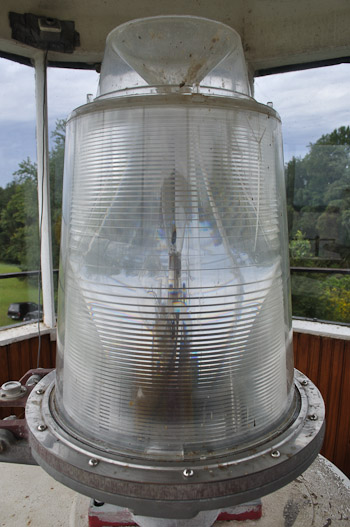 250 MM Lantern (2011) |
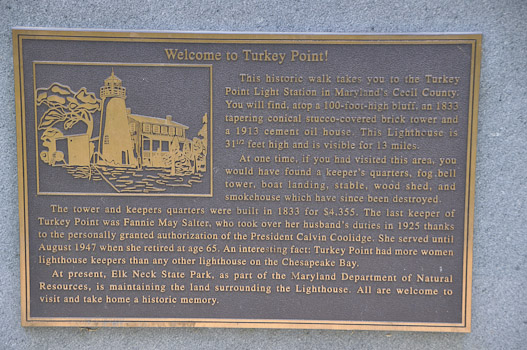 Click image above for larger view (Opens in new window) |
|
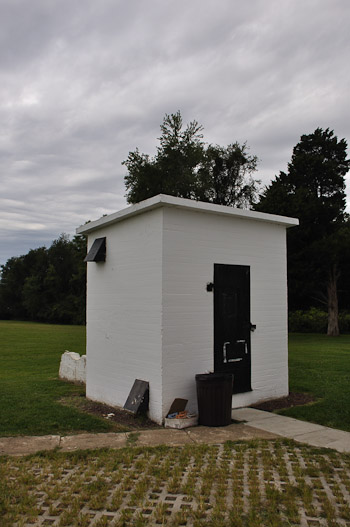 Oil House |
 View from the top, where 5 rivers meet the Chesapeake Bay |
TURKEY POINT LIGHT STATION INC (TPLSI)
Turkey Point Light Station Inc. (TPLSI) is a non-profit organization of
civic and historically minded folks who desire to restore the Turkey Point
Light Station in the scenic Elk Neck State Park to its original condition.
Dean Rice, a retired North East, MD high school teacher, founded the
organization in 1995 after painting the lighthouse for a local service
organization project. The
organization has grown from one person’s dream to a group of over 250
members.
We have taken up the challenge of raising funds to accurately reconstruct
the light keeper’s house in its original location next to the Turkey Point
Lighthouse. We did not expect
to replace the steel ladder and platforms inside the lighthouse with the
rebuilt white oak spiral staircase using the original blueprints first.
WE NEED VOLUNTEERS
PLI works towards achieving these daunting goals and are seeking new
members, volunteers, and individual or corporate sponsors.
With our improvements to the lighthouse, the number of visitors coming to
Turkey Point has increased tremendously.
This is the first time in over 50 years that people can climb the
stairs to the lantern room. We
need volunteers to greet visitors, advise them of the safety rules for
climbers, and share the history of the Lighthouse and surrounding areas.
Whether you are older or younger, we would appreciate your help.
CAN YOU VOLUNTEER? If
you are willing to volunteer some of your weekend time each month, we ask
that you contact us using the information shown below.
WE NEED YOU!
Organization:
(email) TPLS@tpls.org
(web site):www.tpls.org
FUNDRAISING EFFORTS
Current estimates to accurately reconstruct the light keeper’s house are
approximately $400,000. This
does not include the $35,000 to $50,000 to run underground electricity out
to Turkey Point and additional funds to furnish and maintain the Lighthouse
and the Light Keeper’s House.
To achieve these goals, we continue to launch aggressive membership and
fundraising drives seeking interested citizens, businesses, talented
individuals, and other contributors.
Turkey Point Light Station merchandise and gifts can be purchased in our
gift shop on the Lighthouse grounds each weekend between mid-April and
mid-November. We also sell
bottled water and soda for your hike back to the parking lot.
Merchandise is also available at England’s Colony on the Bay and
Kathy’s Corner on Main Stree in North East.
A special Maryland automobile license plate depicting the Turkey Point Light
Station may be purchased from the state by dues paying members.
We now have a Penny Press Machine located at the Elk Neck State Park Camp
Store. Pressed pennies showing
the two different views of the Lighthouse can be purchased at our gift shop
on the Lighthouse grounds.
TPLSI is a 501(c)(3) charitable organization.
All donations are tax deductible.
The above information was taken from a pamphlet received when the light was visited in 2011.
As such, information may have changed.
Email
and website addresses are correct as of December 30, 2019.
Return to the Maryland Lighthouses Page
Return to the: Alphabetical Listing or the Listing by States


